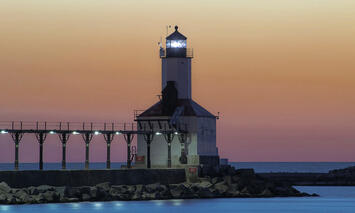
I love the book American Nations: A History of the Eleven Rival Regional Cultures of North America by Colin Woodard. In it, he outlines the regional cultures of America and the impact that each has had on the development of the United States. I think it’s fascinating, mostly because I’m a firm believer in the Shakespearean phrase “what’s past is prologue.” History tells us so much about what could possibly happen in the future.
But I think Woodard got one thing wrong in his book. There should be 12 American nations, not 11. The Great Lakes should be its own regional culture. Furthermore, it should be recognized as the first purely American culture in American history.
Here are the eleven nations as identified by Woodard:
- Yankeedom (New England and the upper Midwest). Settled by English Puritans, they valued education and communal decision-making.
- New Netherland (the greater New York metropolitan area). Founded by the Dutch in the 1600s, this nation has maintained a multicultural and commercial perspective since being established.
- Midlands (stretching from Pennsylvania to the Great Plains of Nebraska and Kansas, widening as it moves westward). Established first by English Quakers and later the Pennsylvania Dutch, it’s been a “go along to get along” kind of region for most of its existence.
- Tidewater (the Chesapeake Bay area). Founded by English who were perhaps most sympathetic to the British Crown, it’s where the plantation economy got its start.
- Greater Appalachia (starting in central Pennsylvania and West Virginia and extending southwestward into Arkansas, Oklahoma and north Texas). Settled by Scots-Irish immigrants, who were accustomed to difficult terrain, the region might be the most ruggedly individualist of them all.
- Deep South (the lowlands just south of the Appalachian Mountains). Tidewater might be where the plantation economy got its start, but the Deep South took it to another level. Probably the most hierarchical region as a result.
- New France (in the U.S., mostly southern Louisiana; in Canada, the most populated parts of Quebec). Not much of this is left in America today, but Cajun culture has left an indelible imprint on the nation.
- El Norte (the length of the U.S./Mexico border, extending into southern California). Founded by Spanish Catholic missionaries, once part of Mexico. An influx of settlers from the Deep South and Appalachian nations turned it into a unique transitional region.
- Far West (generally the area in the U.S. between the Missouri River and the Rocky Mountains). The settlers of the Deep South, Midlands and Yankeedom who wanted more land and just to be left alone moved here.
- The Left Coast (central California up through the Bay Area, beyond Portland and Seattle, and continuing into southeastern Alaska). Probably owes its northern orientation to being founded by New Englanders and the Midlands. But the influence of El Norte and Greater Appalachia is also felt.
- First Nations (the parts of Canada south of the Arctic Circle that include the northern portions of the Prairie Provinces, northern Ontario and northern Quebec). The First Nations influence is much stronger in Canada but can still be felt in the northern Great Lakes.
Read the rest of this piece at The Corner Side Yard.
Pete Saunders is a writer and researcher whose work focuses on urbanism and public policy. Pete has been the editor/publisher of the Corner Side Yard, an urbanist blog, since 2012. Pete is also an urban affairs contributor to Forbes Magazine's online platform. Pete's writings have been published widely in traditional and internet media outlets, including the feature article in the December 2018 issue of Planning Magazine. Pete has more than twenty years' experience in planning, economic development, and community development, with stops in the public, private and non-profit sectors. He lives in Chicago.
Photo: Michigan City lighthouse by Matt Morse, via Wikimedia under CC 3.0 License.













Chicago
I read Woodard's book many years ago, and like Mr. Saunders I enjoyed it immensely. I don't recall if I read the following in Mr. Woodard's book or in some later commentary, but the suggestion was made that the boundary between the Midlands and Yankeedom was Chicago's Howard Ave. Howard Ave. is the northern-most Chicago city limit--the North side of that street is in suburban Evanston.
And it does make sense. Midlanders--in the Quaker tradition--are both immigrant- and Catholic-friendly. And so Chicago is among the most Catholic cities in America, and also famous for its ethnic neighborhoods. Meanwhile, the Yankees are definitely not Catholic, skeptical of foreigners, and put an exaggerated emphasis on education. And also more successful in business.
One notices this difference when crossing Howard Ave. The Chicago side is diverse, ethnic, Catholic. The Evanston side is stodgy, formal, WASPish. Even the architecture is different!
So I think Woodard's analysis is largely correct. There's a big difference between the Midwest and the Upper Midwest. I also think he's right about Ontario--Western Ontario (between Toronto & Windsor) is very Quaker, and much more like Indiana and Central Illinois than either Wisconsin or Minnesota.